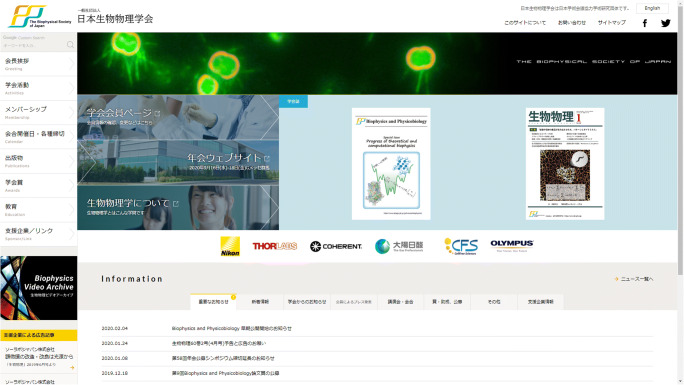Abstract
Our society website was established in 2018 (https://www.biophys.jp/) and currently, it is working for disclosure and communications. However, we should reorganize the site in the near future, to fit to the shift of information media and the need for internalization, as generally requested for the modern Japanese society.
Keywords: The Biophysical Society of Japan, Academic papers, Social network service, Internationalization, Official website, Public outreach
Current status
The website of the Biophysical Society of Japan (hereinafter called “the Society site”) was established around 1998, and its design, device support, and item organization were reorganized in 2018 (Fig. 1). Currently, the Society site contributes to members, potential members, and the general public with regard to the following: (a) disclosure of the rules and structure of the Society, (b) contact and communication to members, (c) publication of academic papers, (d) contact and communication for annual meetings, and (e) contact and communication for public outreach.
Fig. 1.
Top page of the current site (https://www.biophys.jp/)
The Society site had a total of 1,235,502 accesses from January 2016 to August 2019. Considering that the Society has 3050 members as of April 30, 2019, this means that 110 accesses have taken place per year per member.
Problems and future outlook
At present, the committee responsible for the Society site comprises four researcher volunteers. Daily management, updating, design, etc. are outsourced to contractors. However, considering the scale of our society and the fact that the journal committees are composed of 15 members, it is evident that the number of members in the site committee is not sufficient, suggesting that the Society site does not function effectively as the core of information exchange. This can also be discerned from the following facts.
All the Japanese papers, which constitute the most important contents of the Society site, have been handled on the same system since the 1960s, when the Japanese journal, “SEIBUTSU BUTSURI” was the only space for information exchange. The process of recommending, reviewing, and accepting papers, which takes months, remains unchanged. Our Society has accounts on Facebook and Twitter, but they contain the same information as the “Society News” section on the Society site. Academic societies should also perform outreaches as per social demands, and Society sites and social network services (SNSs) can be extremely effective in this regard. However, the outreach site, which is organized separately from the Society site, was established around 1998 and was not renewed so far (however, it is currently being updated). Our Society shifted the presentation format in the annual meeting from Japanese to the English language in 2009, and since then, our Society has promoted internationalization by strictly restricting the use of Japanese. As a result, approximately 7% of participants in annual meetings are foreigners at present. However, most of the content on the Society site is still available only in Japanese.
These problems are not limited to the Society site, but correspond to the unresolved aspects of modern Japanese society, combined with the shift of information media from paper to electronics and even to SNS, and the need for internationalization. In addition, we must be aware that academic societies need to advance their discussion more rapidly and extensively. Nonetheless, in this process of rapid and extensive expansion, the scientific laws that have been clarified until now and the procedure of discussing science must not be neglected.
Author’s background
In 1988, I started my career at Osaka City University, my current place, just after I got PhD on the reaction mechanism of muscle myosin at Osaka University. I studied cell reproduction mechanism of mycoplasma, the smallest bacteria for 9 years, and moved to the mechanism of its motility. Interestingly, mycoplasmas show as many as three special motility mechanisms, which are not related to any motilities found in other organisms. Another current theme is to reproduce the evolution of cell and motility systems by using a synthetic bacterium, JCVI-syn3.0. My motto is to enjoy “borderless biology not limited to Homo sapience matters”. I like the Biophysical Society of Japan, because they accept subjects even outside of the combination between biology and applied physics. I am appointed to the chair of the website committee in 2019 and 2020.



